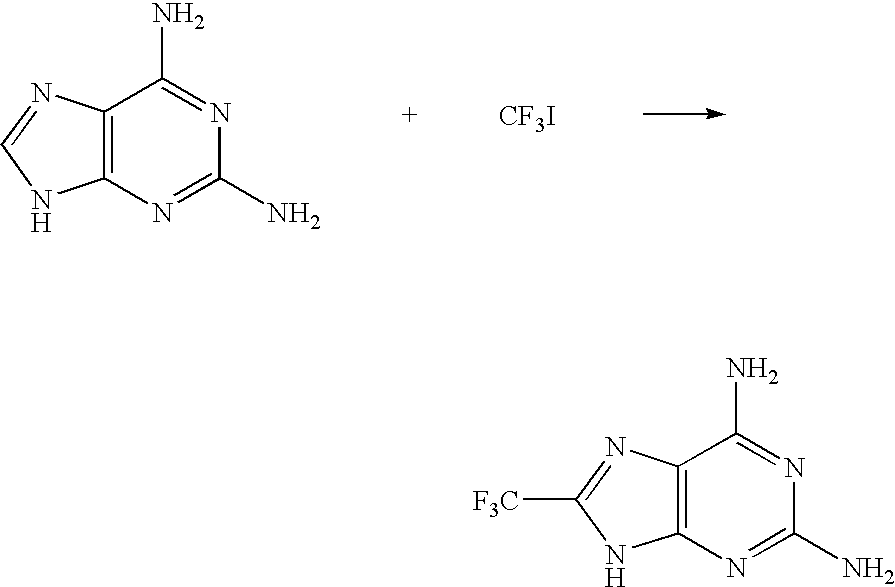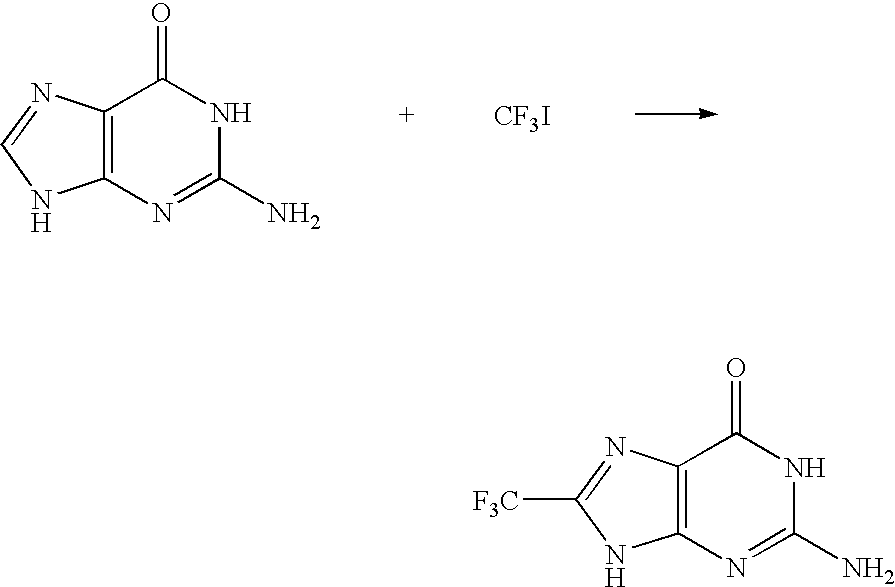Reaction reagent for trifluoromethylation
a trifluoromethylation and reaction reagent technology, applied in the field of reaction reagents, can solve the problems of complex production of (trifluoromethyl)phenyliodonium trifluoromethanesulfonate, industrially difficult to employ, and inconvenient use of xenon difluoride in industrial scale, etc., to achieve good efficiency and high general versatility
- Summary
- Abstract
- Description
- Claims
- Application Information
AI Technical Summary
Benefits of technology
Problems solved by technology
Method used
Image
Examples
example 1
[0065]
[0066]0.12 g (0.8 mmol) of 2,6-diaminopurine was weighed and placed in a two-neck flask and the atmosphere in the flask was replaced with argon. The following materials were added thereinto: 3.0 ml of dimethyl sulfoxide, 0.8 ml of a 3.0 mol / l dimethyl sulfoxide solution of trifluoromethyl iodide, 0.25 ml of a 1.0 mol / l aqueous solution of iron(II) sulfate and 0.15 ml of a 30% hydrogen peroxide aqueous solution, and the mixture was stirred for 20 minutes. During the stirring, the temperature of the reaction system rose up in the range of from 40° C. to 50° C. Thereafter, the resulting solution was cooled to room temperature. Formation of 2,6-diamino-8-trifluoromethylpurine (19F-NMR yield: 40%) was confirmed by 19F-NMR with 2,2,2-trifluoroethanol as an internal standard. Water was added to the resulting solution, sodium hydrogen carbonate was added thereto to neutralize, and the desired product was extracted with ethyl acetate. The extract was passed through column chromatograph...
example 2
[0071]
[0072]0.055 g (0.5 mmol) of uracil was weighed and placed in a two-neck flask and the atmosphere in the flask was replaced with argon. The following materials were added thereinto: 1.0 ml of a 1 N dimethyl sulfoxide solution of sulfuric acid, 0.5 ml of a 2.1 mol / l dimethyl sulfoxide solution of trifluoromethyl iodide, 0.1 ml of a 30% hydrogen peroxide aqueous solution and 0.15 ml of a 1.0 mol / l aqueous solution of iron(II) sulfate, and the mixture was stirred for 20 minutes. During the stirring, the temperature of the reaction system rose up in the range of from 40° C. to 50° C. Thereafter, the resulting solution was cooled to room temperature. Formation of 5-trifluoromethyluracil (19F-NMR yield: 90%) was confirmed by 19F-NMR with 2,2,2-trifluoroethanol as an internal standard. 5-trifluoromethyluracil was obtained as a white solid (0.16 g, yield: 87%) in the same manner as in Example 1.
[0073]1H-NMR (deuterated acetone): δ8.09 (s, 1H), 10.5 (brs, 2H).
[0074]13C-NMR (deuterated a...
example 3
[0077]Formation of 5-trifluoromethyluracil (19F-NMR yield: 75%) was confirmed in the same manner as in Example 2, except that a 1.0 mol / l aqueous solution of ammonium iron(II) sulfate was used instead of the 1.0 mol / l aqueous solution of iron(II) sulfate.
PUM
| Property | Measurement | Unit |
|---|---|---|
| molar ratio | aaaaa | aaaaa |
| temperature | aaaaa | aaaaa |
| temperature | aaaaa | aaaaa |
Abstract
Description
Claims
Application Information
 Login to View More
Login to View More - R&D
- Intellectual Property
- Life Sciences
- Materials
- Tech Scout
- Unparalleled Data Quality
- Higher Quality Content
- 60% Fewer Hallucinations
Browse by: Latest US Patents, China's latest patents, Technical Efficacy Thesaurus, Application Domain, Technology Topic, Popular Technical Reports.
© 2025 PatSnap. All rights reserved.Legal|Privacy policy|Modern Slavery Act Transparency Statement|Sitemap|About US| Contact US: help@patsnap.com



